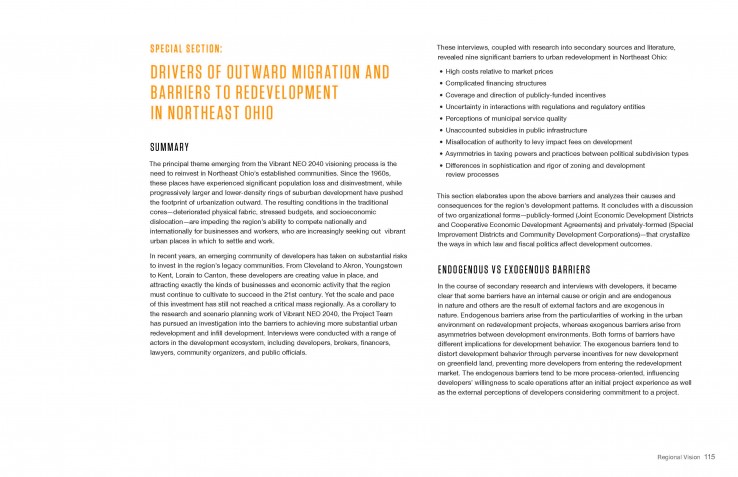SUMMARY (access the complete document here)
The principal theme emerging from the Vibrant NEO 2040 visioning process is the need to reinvest in Northeast Ohio’s established communities. Since the 1960s, these places have experienced significant population loss and disinvestment, while progressively larger and lower-density rings of suburban development have pushed the footprint of urbanization outward. The resulting conditions in the traditional cores—deteriorated physical fabric, stressed budgets, and socioeconomic dislocation—are impeding the region’s ability to compete nationally and internationally for businesses and workers, who are increasingly seeking out vibrant urban places in which to settle and work.
In recent years, an emerging community of developers has taken on substantial risks to invest in the region’s legacy communities. From Cleveland to Akron, Youngstown to Kent, Lorain to Canton, these developers are creating value in place, and attracting exactly the kinds of businesses and economic activity that the region must continue to cultivate to succeed in the 21st century. Yet the scale and pace of this investment has still not reached a critical mass regionally. As a corollary to the research and scenario planning work of Vibrant NEO 2040, the Project Team has pursued an investigation into the barriers to achieving more substantial urban redevelopment and infill development. Interviews were conducted with a range of actors in the development ecosystem, including developers, brokers, financers, lawyers, community organizers, and public officials. These interviews, coupled with research into secondary sources and literature, revealed nine significant barriers to urban redevelopment in Northeast Ohio:
• High costs relative to market prices
• Complicated financing structures
• Coverage and direction of publicly-funded incentives
• Uncertainty in interactions with regulations and regulatory entities
• Perceptions of municipal service quality
• Unaccounted subsidies in public infrastructure
• Misallocation of authority to levy impact fees on development
• Asymmetries in taxing powers and practices between political subdivision types
• Differences in sophistication and rigor of zoning and development review processes
This section elaborates upon the above barriers and analyzes their causes and consequences for the region’s development patterns. It concludes with a discussion of two organizational forms—publicly-formed (Joint Economic Development Districts and Cooperative Economic Development Agreements) and privately-formed (Special Improvement Districts and Community Development Corporations)—that crystallize the ways in which law and fiscal politics affect development outcomes.
Click here to read the entire special section: DRIVERS OF OUTWARD MIGRATION AND BARRIERS TO REDEVELOPMENT IN NORTHEAST OHIO

